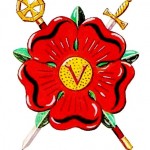 Knight Templar Encampments are reported by various sources as occurring from 1750 onwards The earliest surviving English records of the Knights Templar degree are to be found in Hampshire, in the minutes of the ‘Chapter of Friendship’ now No.257, meeting in Portsmouth, which are dated 21st. October 1778. Commander Dunckerley had written giving the Chapter permission to make Knight Templars and it was resolved to do so. Knight Templar Encampments are reported by various sources as occurring from 1750 onwards The earliest surviving English records of the Knights Templar degree are to be found in Hampshire, in the minutes of the ‘Chapter of Friendship’ now No.257, meeting in Portsmouth, which are dated 21st. October 1778. Commander Dunckerley had written giving the Chapter permission to make Knight Templars and it was resolved to do so.The Chapter’s first Minute Book was written in code as this quote from their founding meeting illustrates: “At a Royal Arch Chapter held in the George Tavern in Portsmouth on First Septr. Seventeen hundred and sixty nie = present Thomas Dunckerley Esq., William Cook ‘Z’, Samuel Palmer ‘H’, Thomas Scanville ‘J’, Henry Dean, Philip Joyes and Thomas Webb. The ‘Pro. G.M.’ Thomas Dunckerley bro’t the warrant of the Chapter and having lately erc’d the Mark he made the bre’n ‘Mark Masons’ and Mark Masters and each chuse their Mark… He also told us this manner of writing …” This simple quotation not only records their foundation but is also the earliest known reference to the Mark Degree and of course includes the most famous Masonic name – Thomas Dunckerley. Their minutes prove the inter-relationship of the Chapter and our Order and they also show the Chapter’s influence in the development of our Order. “Royal Arch Chapter III twenny first October Seventeen hundred and seventy eight. Com. Palmer read a letter from Com. Dunckerley that we might make Knight Templars and it was resolved to.” and just two days later: “At a meeting of the Friendship Chapter III Portsmo. Twenty third of October Seventeen hundred and eighty five. Com. Marks was installed Knight Templar. Com. Palmer appointed ‘Z’.”  These events were taking place in ‘free standing’ units in relatively uncontrolled circumstances. The name of Thomas Dunckerley is significant and appropriate for the founding of what is now “Royal Naval Preceptory and Priory No.2”. A free standing Warrant for the creation of the Encampment of Royal Naval No. 2, is dated 11th. March 1791. These events were taking place in ‘free standing’ units in relatively uncontrolled circumstances. The name of Thomas Dunckerley is significant and appropriate for the founding of what is now “Royal Naval Preceptory and Priory No.2”. A free standing Warrant for the creation of the Encampment of Royal Naval No. 2, is dated 11th. March 1791.A short lived Southampton Encampment Royal Gloucester No.14 followed in 1792 which closed in 1805, but forty years later a new Royal Gloucester No. 32 was created so possessing a very unique warrant. Two attempts to establish working in Winchester failed to come to reality, but slowly the order did arrive in Alton, Bournemouth, Ryde, a second Preceptory in Portsmouth (now meeting at Havant), Basingstoke later to move to Andover, Petersfield, Botley, Freshwater and most recently a ‘daylight’ Preceptory at Chandler’s Ford. Additionally the Sepulchre Preceptory No, 27, founded in 1840, in Calcutta, relocated to Hampshire and now meets at Mudeford. The Province was created in 1848 but did not include the Isle of Wight at that time. Vectis Preceptory No. 237 was warranted in March 1925, being of ‘free standing’ and it was not until 1945 that we were united. To celebrate the ‘union’ the Annual Provincial meeting was held in Ryde in 1946. This ‘moveable feast’ was again scheduled for the Island in 1965. The Minute Book sadly records that “the meeting was held under exceptional difficulty due to the dense fog in the Solent”. Strangely there has never been an Annual Provincial Meeting called on the island since, despite the great improvement in radar systems in the ensuing years! Annual meetings came to a more settled existence in Bournemouth for many years but more recently have taken place at Botley. Since the formation of the Province in 1848 we have had a remarkable range of men as Provincial Priors (see below), ranging through an Admiral, an M.P., other Naval and Army Officers, the clergy and a couple of engineers. This is a true reflection of the eclectic mix of our membership which is totally applicable to a truly Christian Order. A further example of the enduring nature of this Order and the early influence of Royal Naval No.2 is the fact that the ritual used today throughout our Great Priory (with the exception of Bristol) is virtually the same as that in use in No.2 in 1851. A very comprehensive account of our History was written by E.Kt. Peter F. Wyles J.P., P.Gt.W.of R. in 2002; Copies of which are available from the Provincial Vice-Chancellor Provincial Commanders and Priors1848 – Major Ferris Charles Robb Provincial Deputy Commanders and Sub-Priors1856 – Charles Ewens Deacon 2019 – Julian Mitchell
|